Google SEO Outbound Link Building: a guide to backlink building
This is a complete guide to building Google outbound links in 2024.
So if you want to build quality backlinks to your site, the actionable tips in this new guide can guide you through the process.
Let's get right to it.
This guide is as follows:
The Basics of External Link Building
Chapter 1
In this chapter, I will answer the question, "What is link building?" .
I'll also show you why link building is still important for SEO in 2024.
What is outbound link building?
External link building is the practice of creating one-way hyperlinks (also known as "backlinks") to a website in order to improve visibility in search engines. Common link building strategies include content marketing, building useful tools, email promotion, broken link building and public relations.
Why are external links so important?
To understand this, you have to go back to the days of the Internet before Google came along. Back then, search engines like Yahoo and Altavista were the dominant players. And they 100% ranked search results based on web page content.
It wasn't until Google came along and the famous PageRank algorithm changed the game. Instead of just analyzing the content of a page, Google looked at how many people were linking to that page.
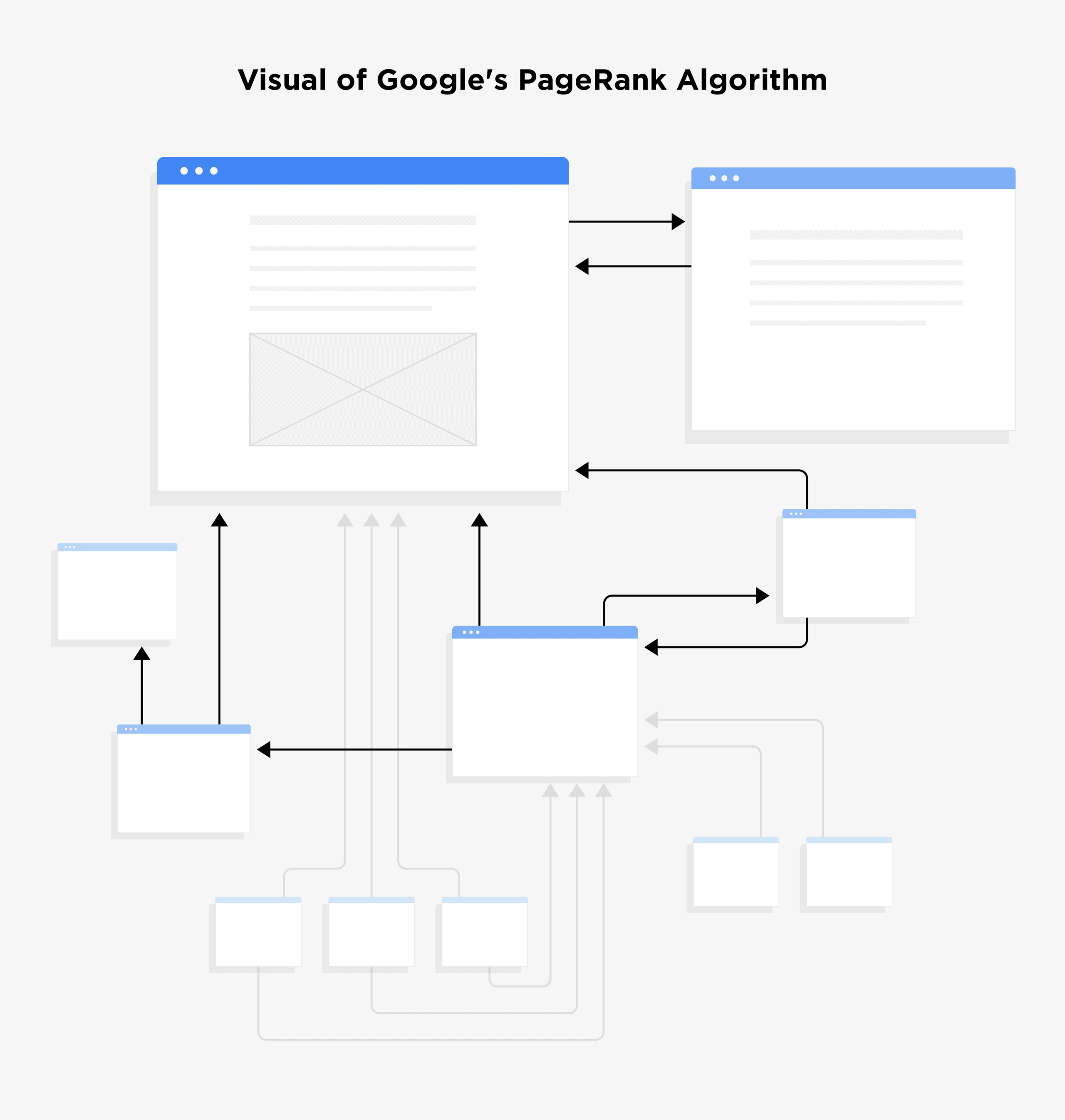
And they were right. Nearly 20 years later, links are still the best way to determine the quality of a web page. That's why backlinks are still Google's preferred ranking signal.
However, with updates such as Google Penguin (the codename for Google's algorithm updates), Google is now paying more attention toLink Quality(and not just the number of links).
You may be wondering: what exactly are quality links and how do I build them?
This is what I will cover in the next chapter. Continue reading at ......
Chapter 2
How to find quality links
Before we dive into outbound link building strategies, it's important to understand what makes a good (or bad) link.
This way, you can focus on building outbound links that will help improve your Google rankings. Here's how to recognize the links that are really worth building:
page authority
Is the page pointing to you a PageRank powerhouse? If so, then that link will have a big impact on your rankings.
From years of testing, I've found that the authority of the page linking to you is more important than any other factor. This is because links from authoritative pages pass more weight (also known as PageRank) to your site.
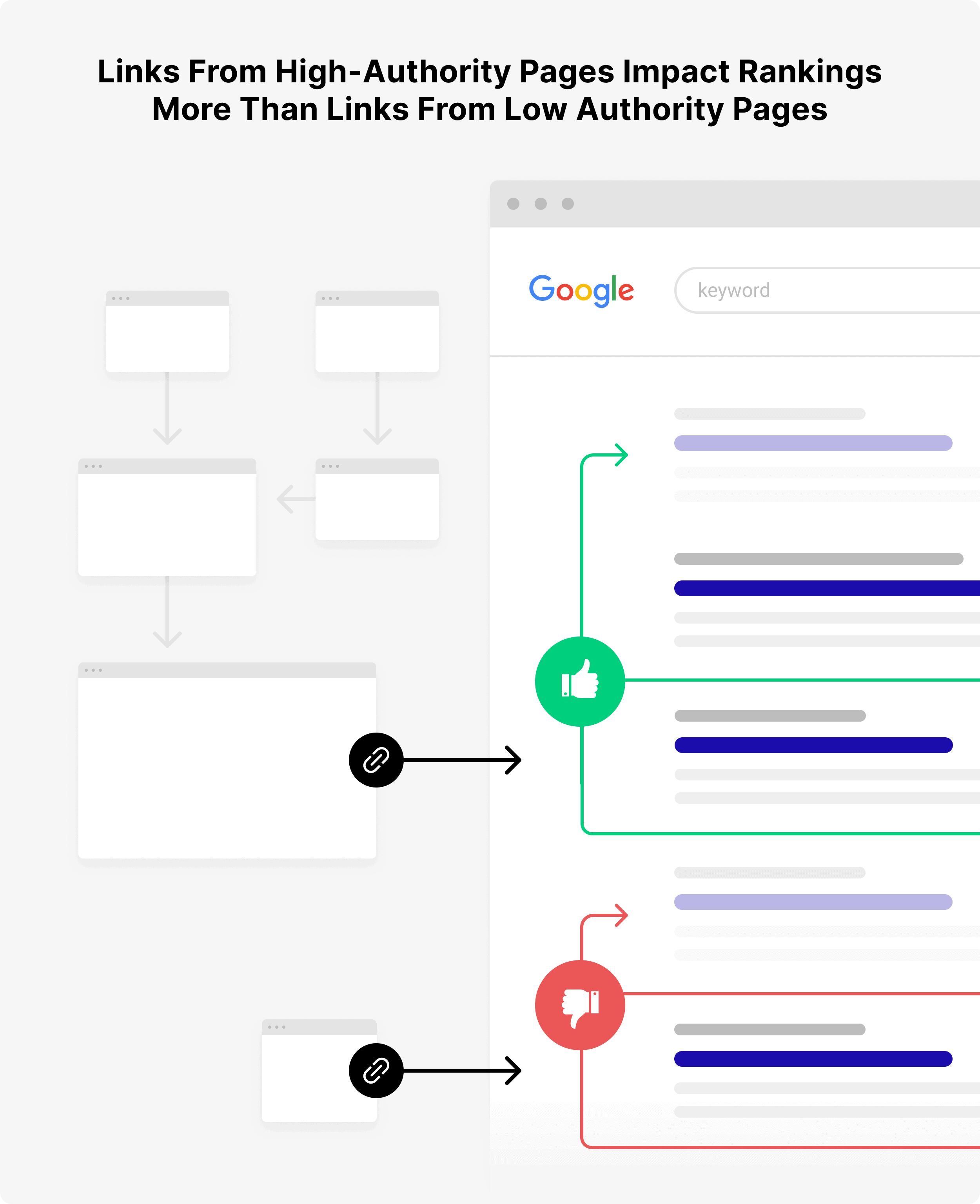
(Note: Although Google does not share PageRank (weight) information publicly, they still use it as the basis for their algorithm.)
You can use theSemrushEasily check PageRank ("PageRating") predictors. Simply drop a URL into Semrush and check its "PageRating":

Website Permissions
The quality of the links also depends on the domainsite-wide access(which can be interpreted asweights).
Usually, links from high-powered sites have a much bigger impact than links from no-name bloggers. This is where Semrush comes in handy. Enter the root URL into the tool and check its "authority score".
Site Relevance
When it comes to links, the authority of the site matters. But the site's relevance is also important.
For example, let's say you run a website about wilderness survival diets. And you get a link from an authority site about unicycling, will that link still count?
According to an interview with a former Google employee, such outbound links are ineffective or of limited effectiveness.
According to Google engineers, "...... Getting a link from a high PageRank page used to be always valuable, but today, relevance to your site's topic is more important, and relevance is the new PageRank."
So the prerequisite for getting links from authority sites are high authority sites that are relevant to your type of website.
Location of links on the page
Your link is embedded in a piece of content:

Still in the footer:
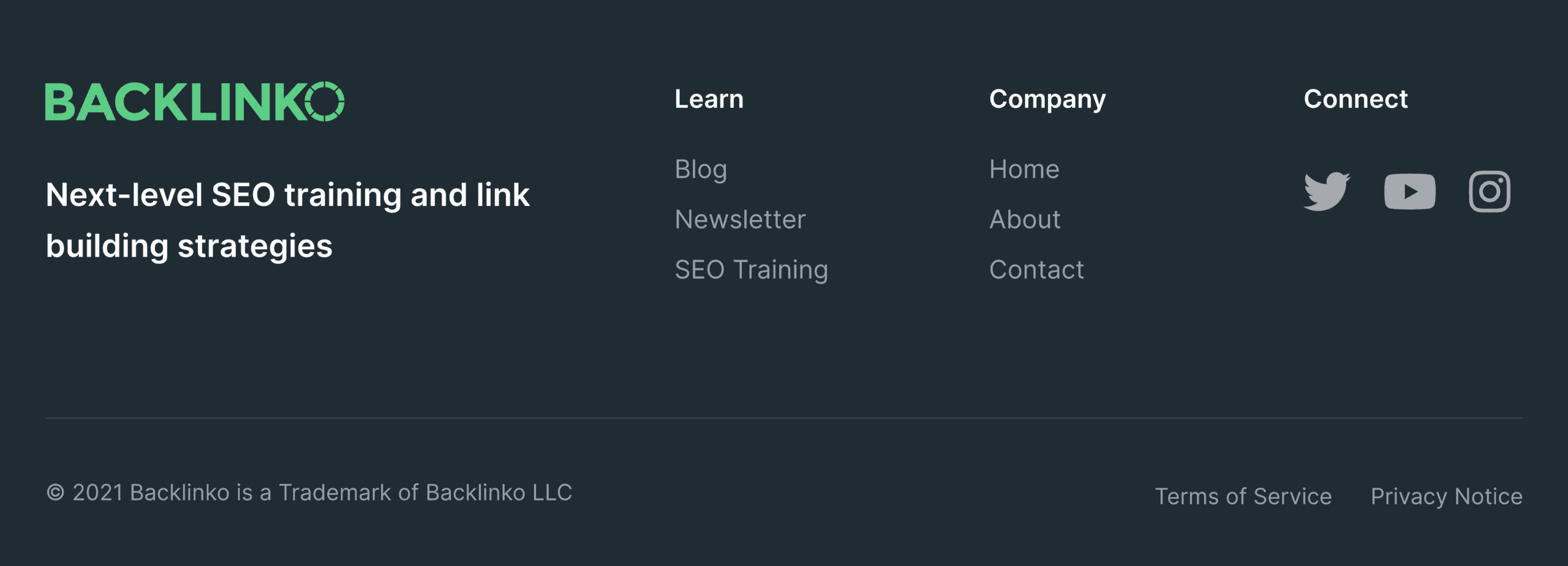
The two effects are different and youPosition of the link on the pageIt's important.
Specifically, links hidden in footers and sidebars are far less valuable than links found in the middle of the main content of the page. That's why you should make your website links appear in the main content section of the page.
Are the links placed editorially?
Regardless of where your links appear on the page, editorially placed links are different from automatically generated or user-generated links.
Links manually placed by editors are usually considered more valuable because they have been carefully selected and placed by content editors, meaning that they are useful and relevant to the content in question.
Search engines also tend to find links manually placed by editors more credible, and therefore may give higher weight to these links. Creating an account on a random site to leave a link is not an editorial link.
Ensuring that links are manually placed by editors improves the quality and credibility of the links, leading to more effective SEO results.
From Google: Creating links that have not been placed editorially or vouched for by the site owner (also known as unnatural links) may be considered a violation of our guidelines.
Link Anchor Text
Anchor text is the clickable text portion of a link.
It has been proven that Google uses anchor text as a ranking signal. For example, let's say you get a link to your site with the anchor text: "paleo desserts".
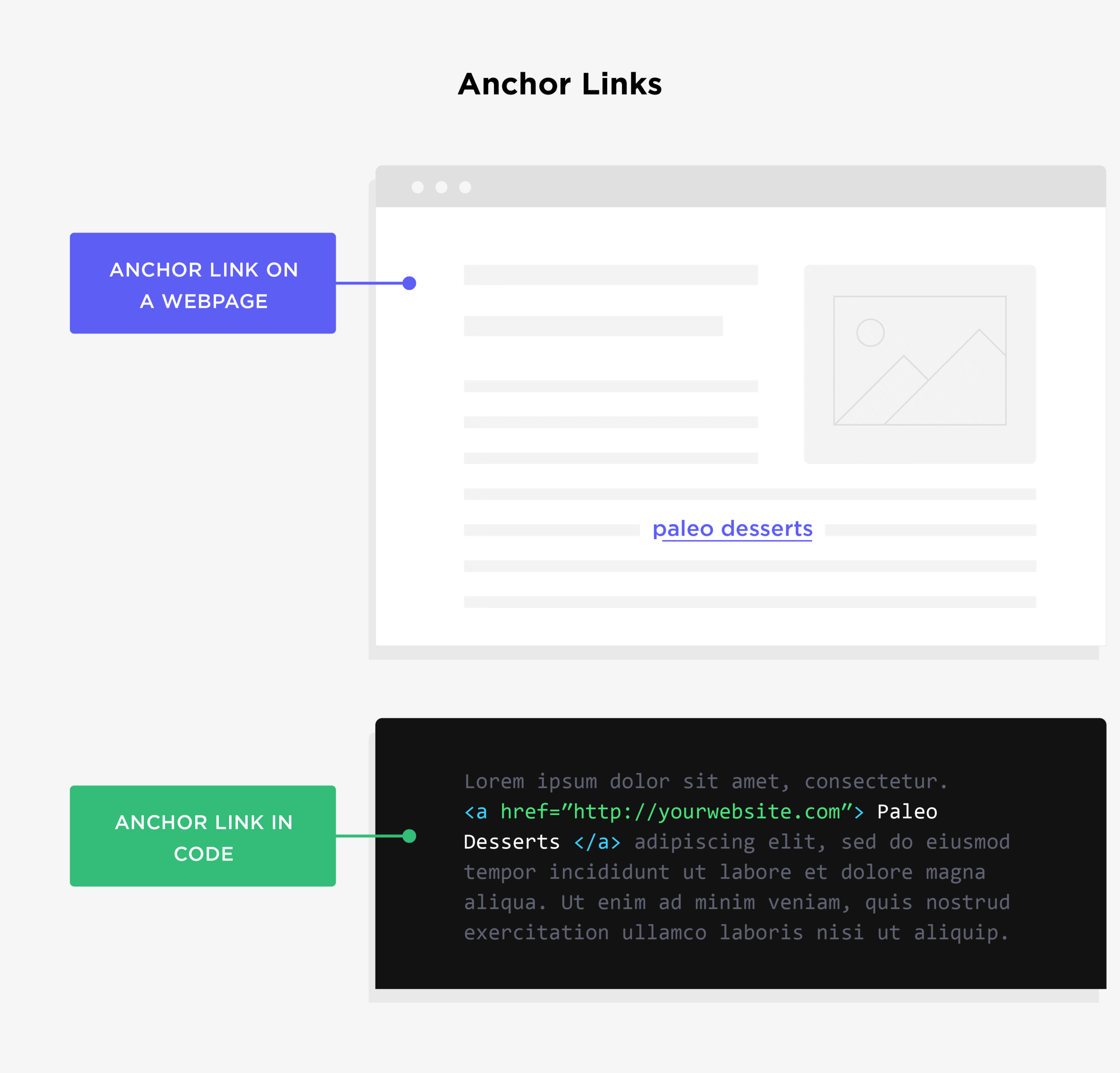
Google sees that anchor text and says, "Hmmm. That site is using the anchor text: 'paleo desserts'. The page they're linking to must be about 'paleo desserts'."
Of course, just like anything in SEO, keyword-rich anchor text has been abused. These days, building tons of exact match anchor text links is considered spam.
Here's an example of what I'm talking about:

In short, I don't recommend using keyword-rich anchor text for link building. However, if you do get a link with a keyword in the anchor text, then it's time to celebrate.
hyperlink
Co-occurrences are words and phrases that appear around a link. Google may use co-occurring words as "not exact match anchor text" (contextual links).
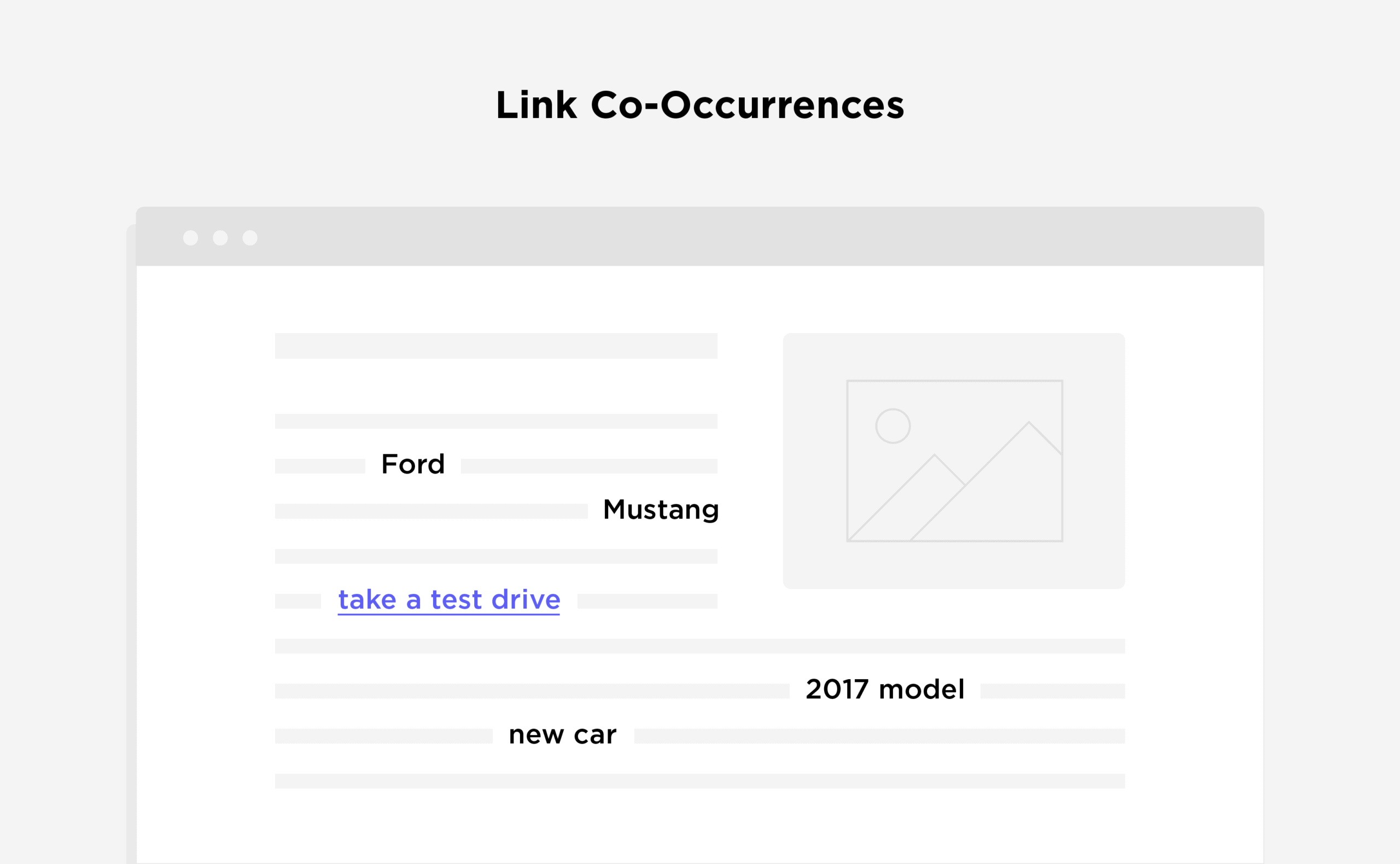
If you think about it, it makes sense: the text around the link also provides clues to the content of your page. Google naturally uses these words as references.
Is the link from a guest post?
A few years ago, Google said it with a straight face:
So give it up: guest blogging is over; it's become too spammy. - Matt Cutts, former head of Google's web spam team
Really?
Well ...... it depends.
Here are some red flags that can make guest posting spam:
- Someone paid to post this
- The post contains exact match anchor text
- The site exists only for the purpose of posting visitor posts
- This site is not related to your site
But if you're in ahigh,pertinentWhat about an amazing guest post on a website? In my experience, this link can help you rank.
Nofollow .vs.
rel="nofollow" is a tag added to a link that tells search engines, "Do not treat this link as an endorsement."
Obviously, when it comes to SEO, you want normal, "dofollow" links whenever possible. Now that you know how to evaluate the quality of your links, it's time to start building them.
Chapter 3
How to get world-class links through content marketing
It's no secret that content is the key to getting amazing backlinks.
But.Simply posting content won't bring you any links.Certain types of content have proven to be best for link building.
Here are the 4 types of content that tend to generate the most links:
1. Visual assets
What is it?
Visualization assets are:
- photograph
- diagrams
- infographic
- Charts and other visually oriented content
Why it works.
Visual content is super easy to link to. For example, when you post a chart on your site, every time someone shares it on their site, you get a link.
This powerful "share my image and link to me when you do" relationship simply doesn't work for text-based content.
Real Life Cases:
A few years ago, I posted this visualization of Google's CTR on my website.

The visualization has been linked to dozens of times so far (many of them from authoritative sites in the marketing field), and some of these links appear even when I list the same data in a table.
But a large portion of these links (I'd estimate 75%) were created because I was presenting the information in a visual way.
In fact, a lot of my backlinks come from people posting my visualizations directly on their sites (and linking back to me as the source):
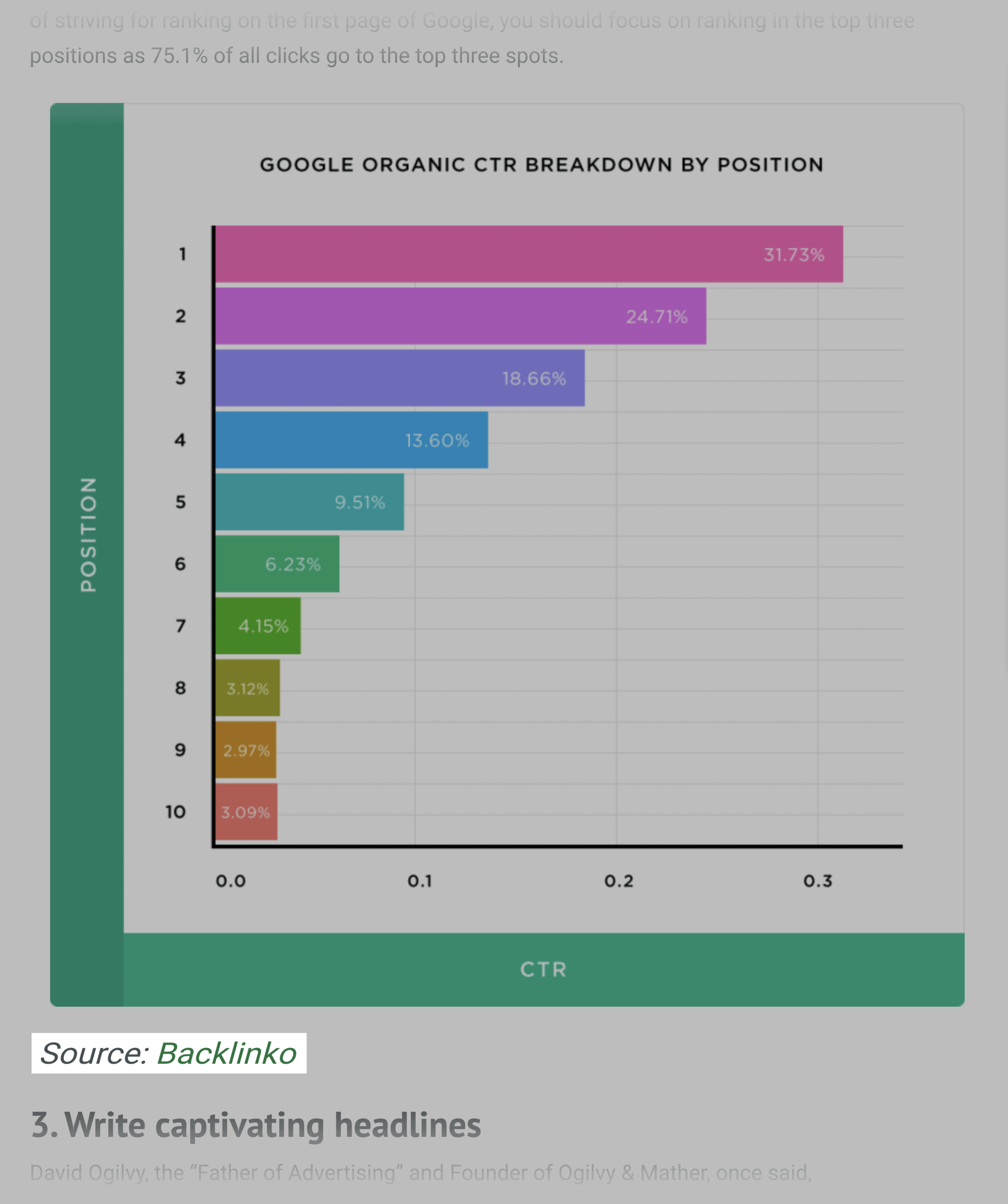
It's interesting to note that even though it's been a few years, people still link to my visualizations every month. That's the power of creating visual assets.
2. List the posts
What is it?
A numbered list of tips, tricks, causes, myths ...... or anything else.
Why it works:
List posts pack a lot of value into easy-to-understand, easy-to-eat chunks.
When BuzzSumo analyzed 1 million articles, they found that list posts generated more backlinks than other content formats ...... outperformed quizzes, videos and even infographics.

This list post, 19 New SEO Techniques, is one of my all-time favorites. Yes, it generates tons of shares...

... and notes.

But the bottom line is that this kind of headline-grabbing list post is really hot. And because the page has so many links pointing to it, it ranks in the top 5 for the keyword "SEO techniques".
3. Original research and data
What is it?
Displays the content of new data from industry studies, surveys, or primary research.
Why it works:
Statistical information and data are highly linkable. When someone references your data, they link to you. These links add up quickly.
Real Life Cases:
Not long ago, I published the largest study of Google's ranking factors ever. This article contains tons of raw research data. That's why this article has amassed a whopping 18.9k links so far.
Like I mentioned above, most of these links come from people citing specific statistics from our study:
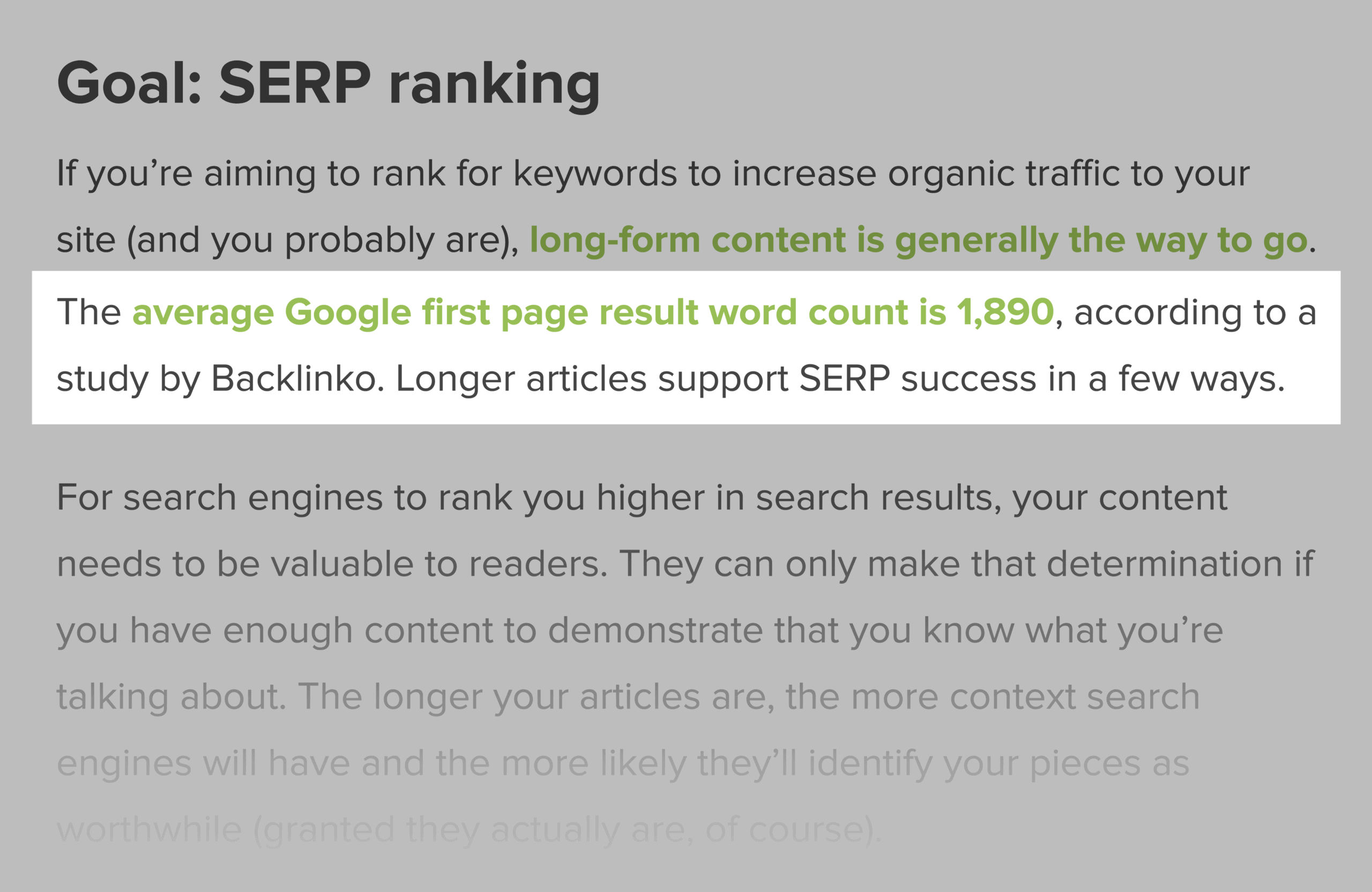
4. In-depth Ultimate Guide
What is it?
A comprehensive resource that covers everything (and more) about a given topic.
Why it works:
The Ultimate Guide provides a wealth of information in one place. This makes your guide the go-to resource for the topic.
Real Life Cases:
I used to get emails every day from people asking me for advice on keyword research. Unfortunately, I don't have anything on my blog that covers that very important topic.
Now that you've created link-worthy content, it's time to build some links.
How to build it? Through good old-fashioned email promotion.
Chapter 4
How to Build Powerful Outbound Links with Email Promotions
If you want to build white hat links in 2024 (and beyond), you need to use email outreach.
The question is: How do I reach bloggers and journalists without getting put in the spam folder?
Read this chapter to find the answer.
1. Finding "potential linkers"
As the name suggests, "potential linkers" are people who might link to you.
I'll show you in Chapter 6 the many ways to find possiblepotential linkerof the technology. But for now, let's identify them using a simple strategy: reverse engineering.
First, search for your target keywords in Google.
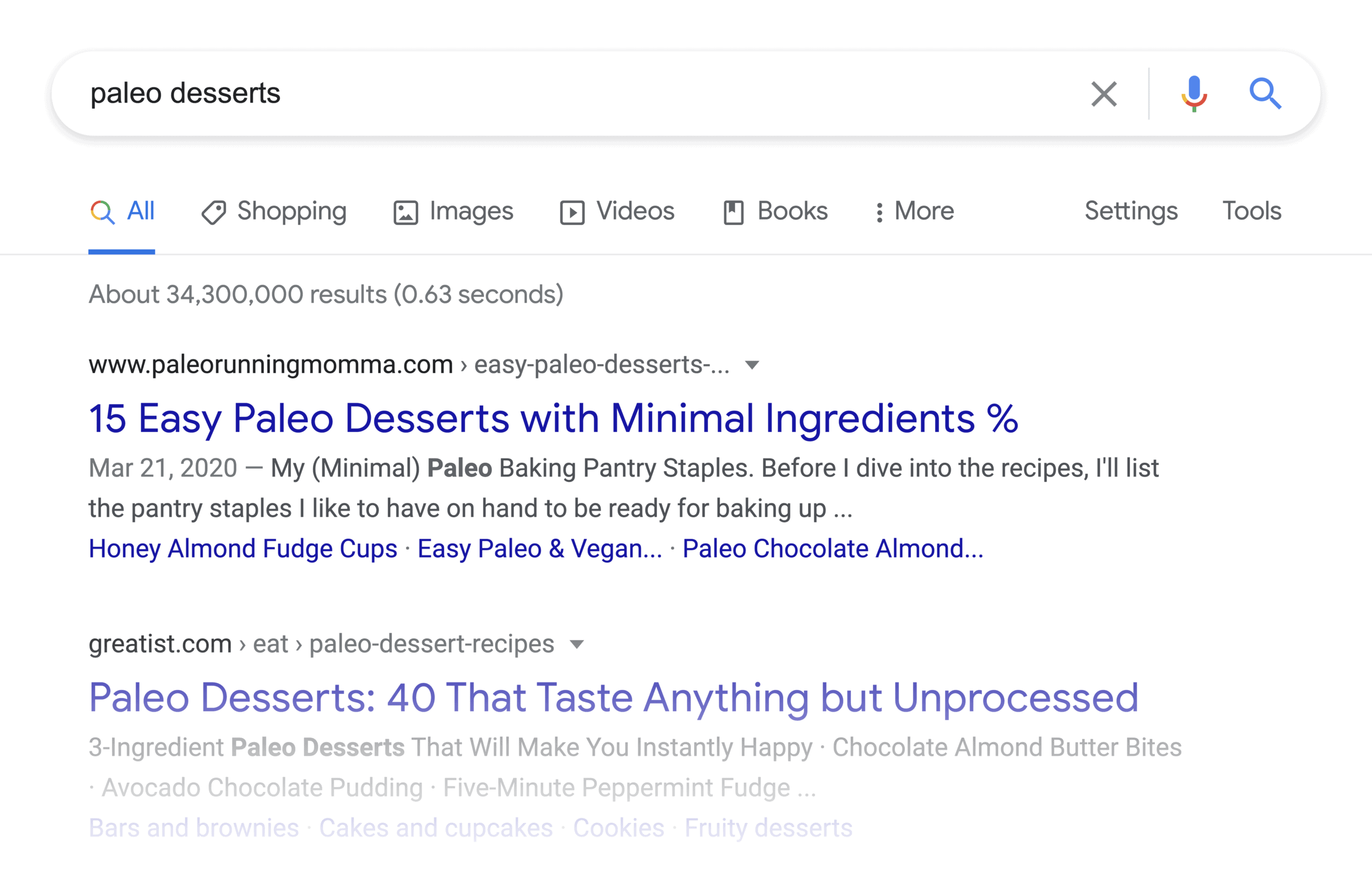
Get the URL of the first result and put it into a link analysis tool (in this case I'm using Semrush).
Next, click on "Backlink Analysis" in the sidebar and then "Backlinks": the sites listed here are potential linkers.

The sites listed here are all possible linkers.

(How do you know which sites to target and which to ignore? Check out Chapter 2).
2. Find their email address
Now that you've found a possible linker, it's time to dig into their email address.
PRO TIP: Only use a website's contact form as a last resort, it's usually a black hole of information.
Here's how:
utilizationHunter.ioHunter is perfect for contacting small websites and personal blogs.
Simply enter the site into the tool:

It will display all email addresses associated with the domain:
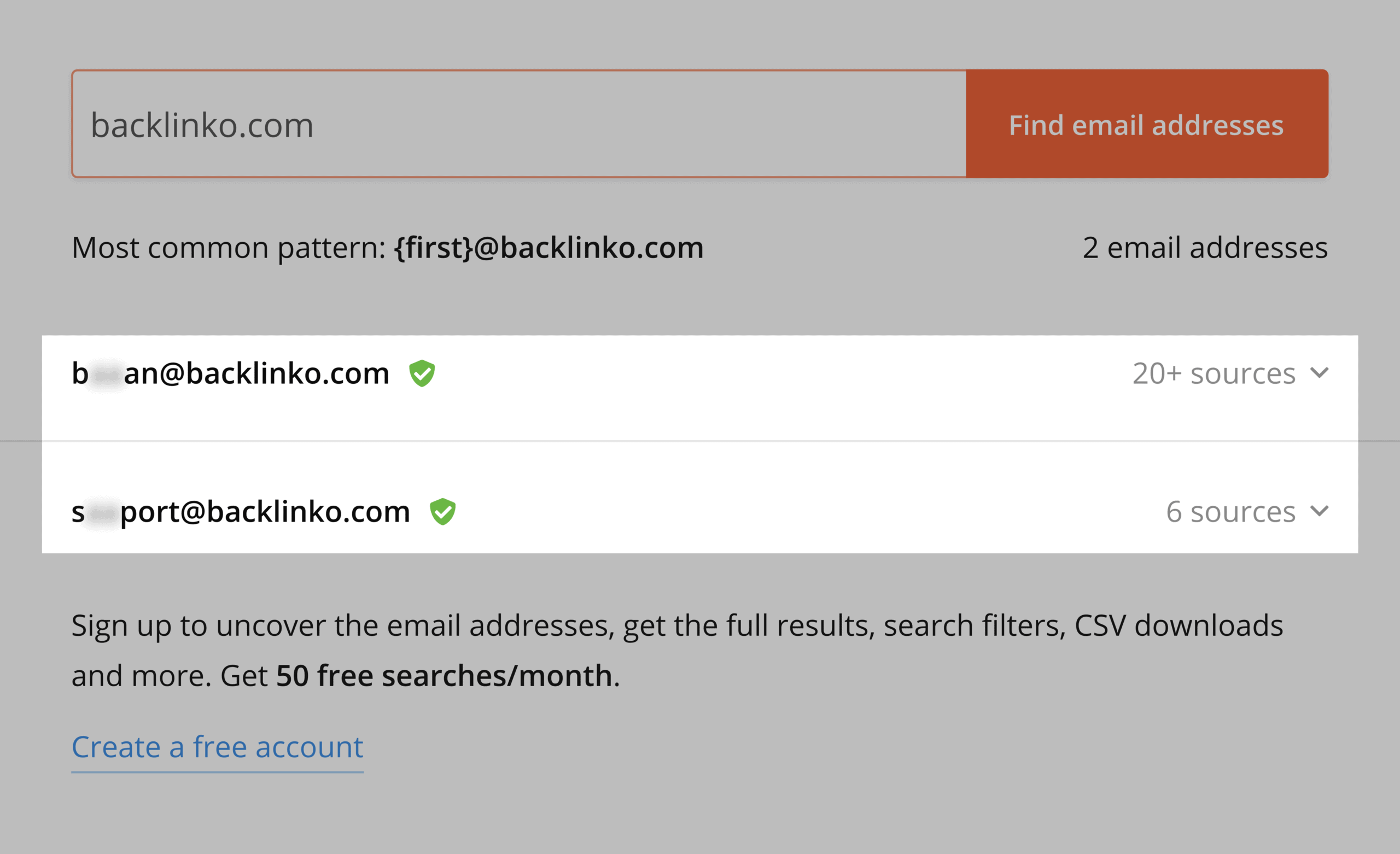
But what if you want to reach out to a large site? Sorting through that list will be a pain. So in those cases, I recommendVoila NorbertThe
Voila Norbert
With VoilaNorbert, you don't need to enter a URL, just someone's name and their domain name.
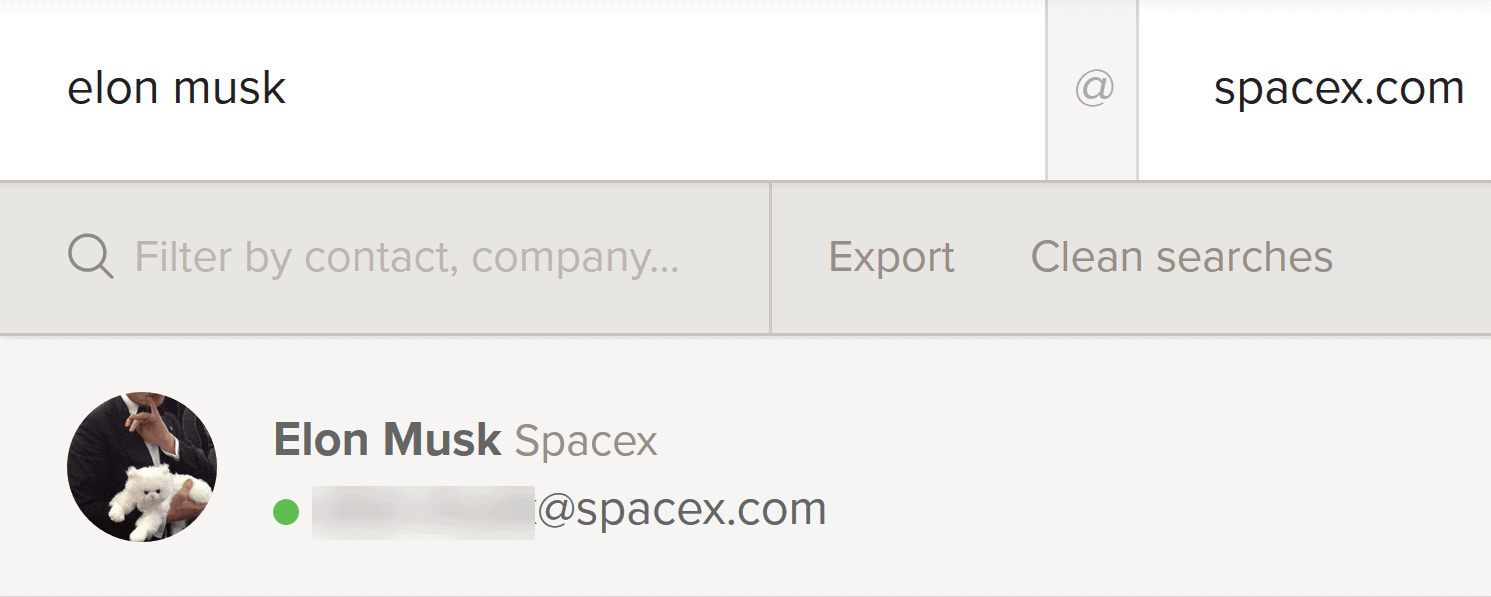
This way you can reach out to the person who can actually add your link to their page and get the person's email address.
3. Send them a (personalized) script
If you want to extend the outreach, you need to use a script. The trick is to make your scripts not look like scripts (more on this in the next step).
But for now, here's an example of my best performing email script:
Hello [name].
I stumbled upon your post today while looking for something on [subject]: [article title].
Good stuff! I especially like [specifics from their article].
Also, I just posted a new guide on [your topic]: [URL].
As someone who writes about [topic], I thought you'd like it.
My guide may also be a great addition to your page. Either way, keep up the awesome work with [Website]!I'll see you later.
[Your name]
Please note that this script allows for a lot of personalization without a lot of effort.
Chapter 5
The Truth About Black Hat Outbound Link Building (and Google Penalties)
No guide on building links would be complete without a section on black hat SEO. Black hat outbound link building is easy to spot: if the links violate Google's Webmaster Guidelines, then they are likely to be black hat links.
Does this mean you should avoid black hat link building altogether? Personally, I don't recommend black hat link building (the risks are insignificant compared to the rewards).
Whether you're a white hat SEO or a black hat SEO, you need to know what penalties Google will give. So let's go over them briefly:
Google Penguin
What is it?
A website penalty algorithm that specifically targets sites that use spammy link building techniques such as dubious guest posting and blog comment spam.
How to Avoid Departure Google Penalties:
Build only white hat outbound links.There is data that suggests you can dodge Penguin by minimizing exact match anchor text (which I think is part of the story ...... but is more about trust). i.e. the easiest way to avoid Penguin is to avoid suspicious links (no matter what the anchor text is).
Artificial penalties/unnatural links
What is it?
Google employee manual penalties. Unlike Penguin, Google will send you a message through the Google Search Console:
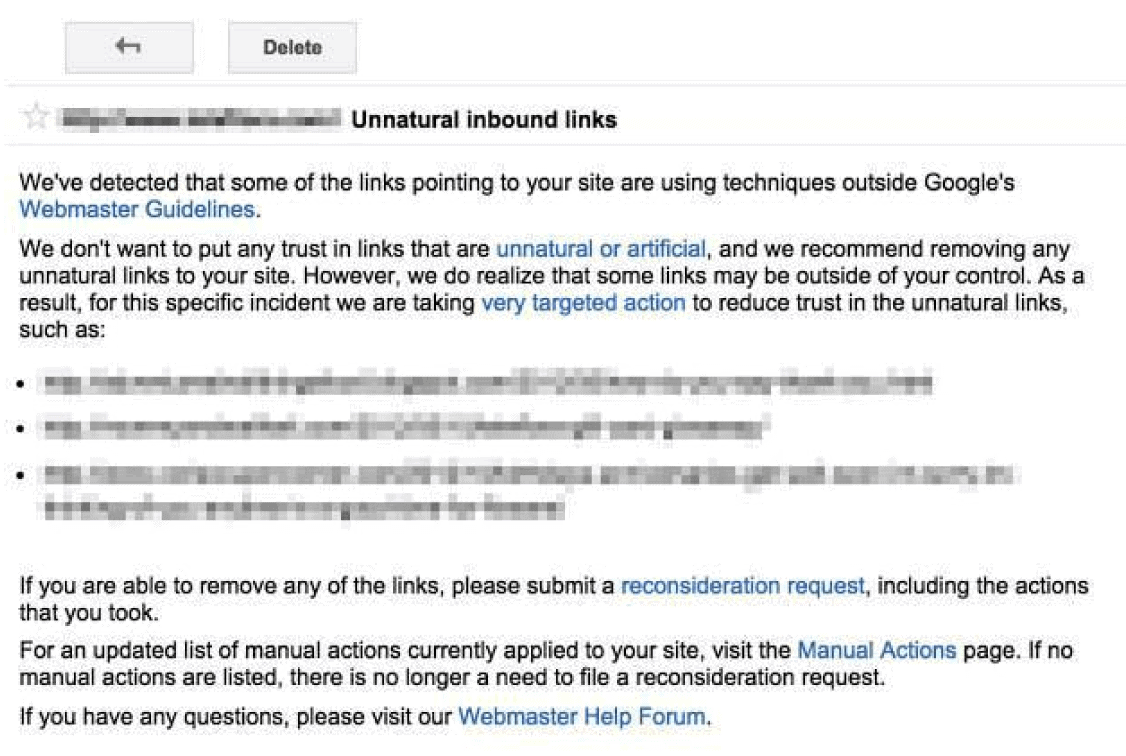
How to avoid it:
No one outside of Google knows how sites are manually penalized. The way I see it, the algorithm will find a site that may be cheating the system. They will then submit that site to someone at Google for manual review. Therefore, the best way to avoid manual penalties is to have a very clean link profile.
Also, unlike Penguin, you can recover from a manual penalty by rejecting the link and submitting a reconsideration request.
Chapter 6
My Three Favorite Link Building Strategies (Step-by-Step Tutorial)
Here are 3 of my tried and true strategies for building tons of world class backlinks:
Resource page link building
What is a resource page? A resource page is a page of high quality content that points to a given topic.
Here's an example:
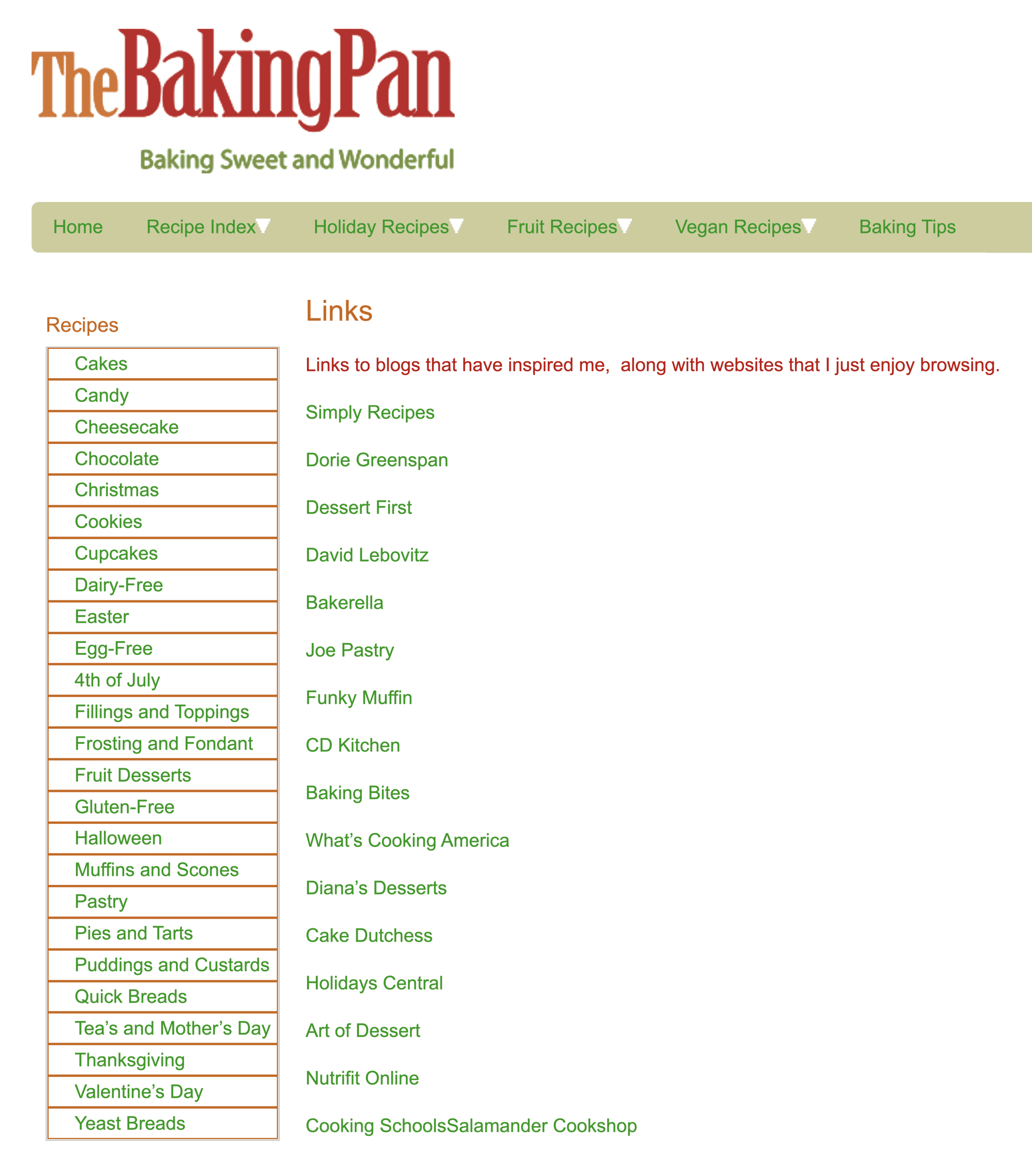
Because these pages exist solely for the purpose of linking out, they are perfect link building targets.
Here is the step-by-step process:
1. Find Resources page
Use these search strings in Google, they are specifically designed for mining resource pages:
"keywords "+inurl:links
"Keywords" + "helpful resources"
"Keywords" + "useful resources"
"Keywords" + "useful links"
2. Assessment page
This is where you (quickly) answer the question: are the links on this page worth the effort? (Hint: use the tips in Chapter 2 to make this step easy)
For example, this resource page has a URLRating (UR) of 12, which is quite good.
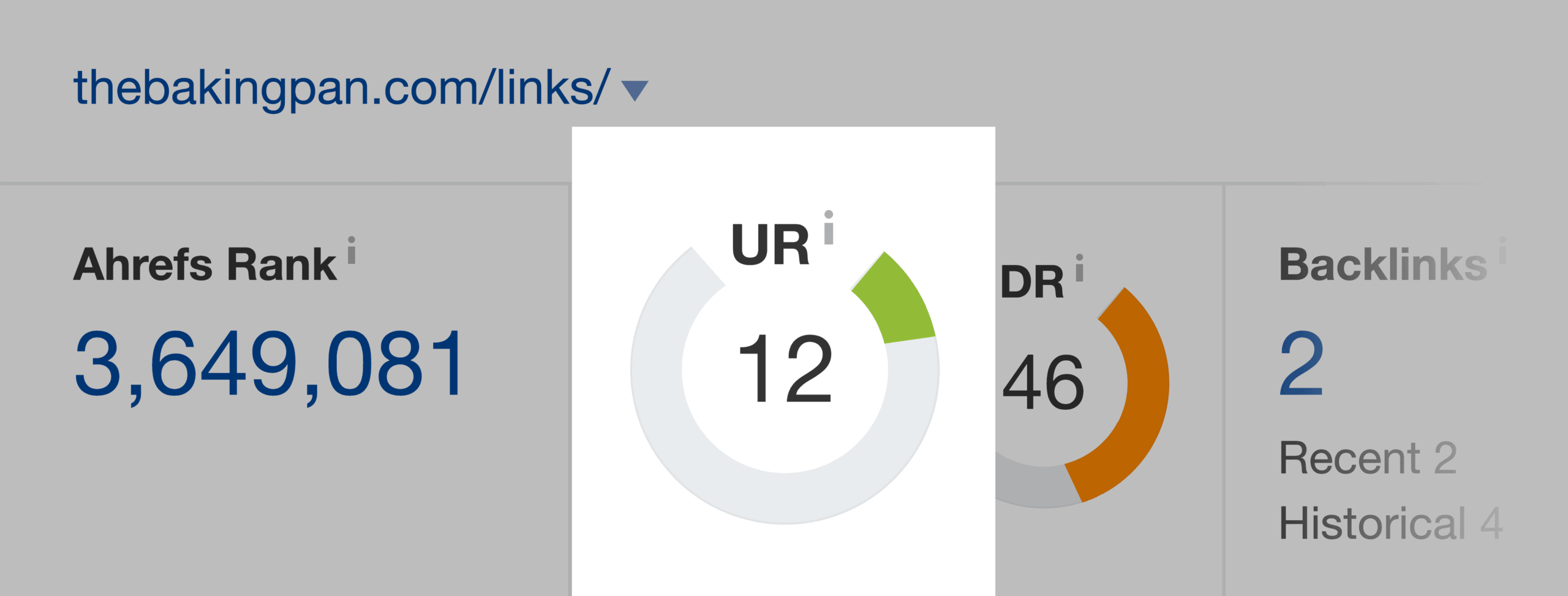
It's also on the authority domain, and my link ends up in the main body of the page.
Supplement: UR and the previously mentioned PR in fact all represent weight, PR is Google's official weight rating given early, now not public.
And UR is a weight score provided by third-party SEO tools based on the number and quality of backlinks, etc.
3. Finding the "best match" content
Your content can be the best in the world, but what if it doesn't fit on that resource page? You won't get the link.
So, for this step, find content on your site that perfectly matches that resource page. Once you've identified that content, move on to step 4.
4. Send this tested script
This is the script I recommend:
Subject: question about [their website
-
Hello, [username]
I stumbled upon your excellent resource page this morning when I was searching on Google about [topic]: [url].
I just wanted to say that your page has helped me a lot. Without it, I would never have found [the resources they link to].
It's funny: I just posted a guide on [subject] last month. It was [brief description].
If you'd like to check it out, here it is:[URL].
Also, my guide might be a good addition to your page.
Anyway, thanks for organizing your resource list. Have a wonderful day!
I'll see you later.
[Your name]
PRO TIP: As with all expansion scripts, make sure to personalize this script as much as possible. As long as it doesn't look like a script, you can use a script.
broken chain construction
Broken link building is one of my all time favorite link building strategies.
Why?
With the broken link build method, you don't request the link directly, but rather theAdding value to each other's websitesThe
Here's how it works:
Install Check My Links or LinkMiner.
Both tools can quickly find broken links on any page (in your Chrome browser).
I'll show how to use them in a minute.
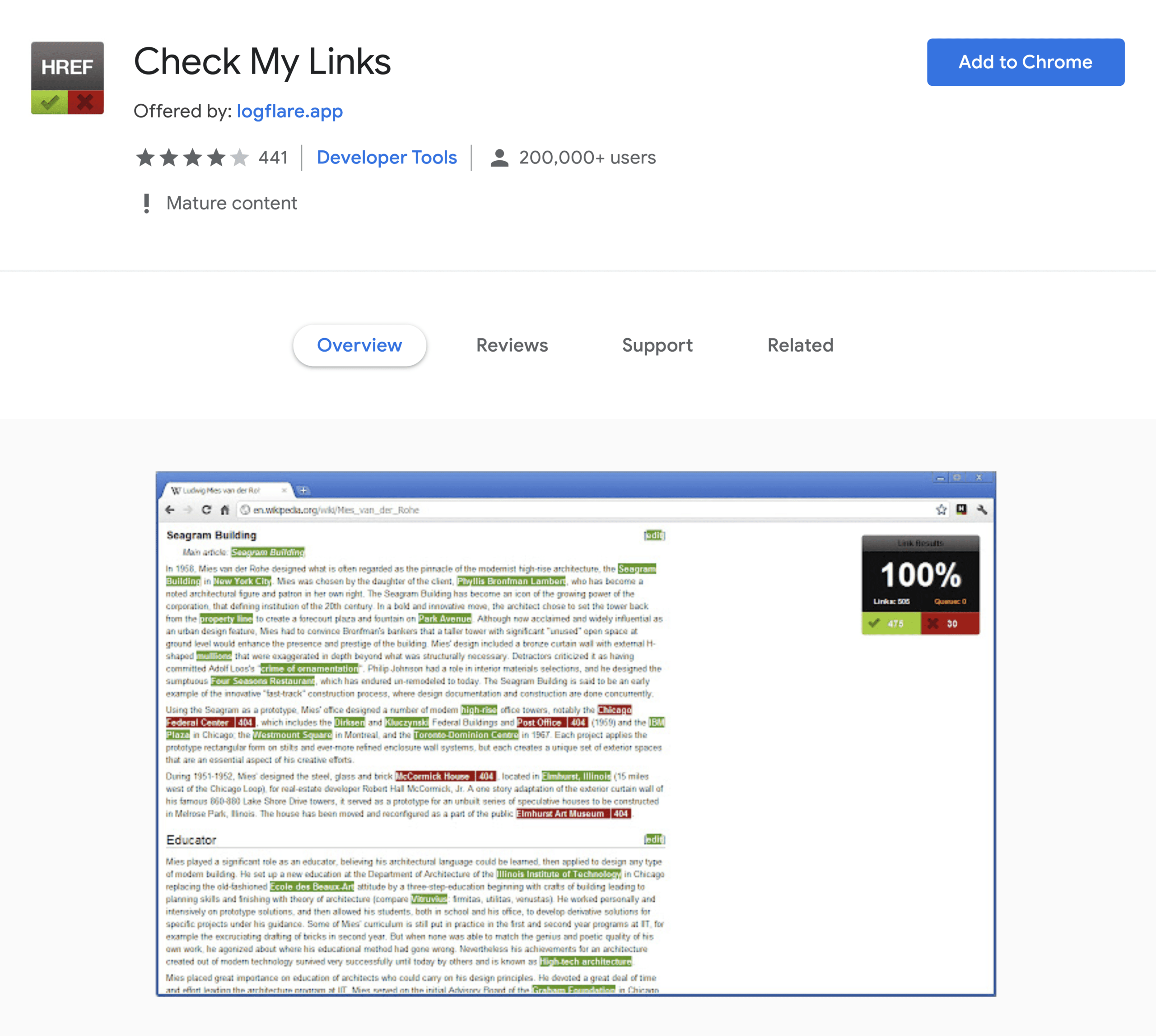
② Finding pages with a lot of outbound links
The more links a page has, the more likely it is that one of them will have a problem. Resource pages work well here, so you can use the search string above to bring up the resource page.
③Check for broken chains
This is where you run the extensions you installed in the first step, and they will show broken links on this page:

④Contact the website owner by e-mail to inform him/her that the link is broken.
Finally, let the person running the page know about their broken link (or links) and market your site's content as an alternative.
This is the script I recommend:
Subject: [name of their website] has questions
-
Hello, [username]
Are you still updating your website?
I stumbled upon your wonderful page while searching for something about [topic]: [page title or URL].
However, I've noticed a couple of links that don't seem to work: the[URL of broken link]
In addition, I recently posted [brief description of contents]. It might be a good replacement for [point to specific broken link].
Either way, I hope this helps you 🙂 .Thank you.
[Your name]
Skyscraper technology
This section has been posted before, so you can go directly to it:Skyscraper technology: a case study in content SEO link building
After understanding skyscraper technology, it's time to move on to the next chapter: a case study in bullish link building!
Chapter 7:
Link Building Case Studies
Now it's time to show you real examples of link building in action.
Case study I
How Julie Used Skyscraper Technology to Increase Natural Flow by 194.1 Percent
Julie Adams' blog, Our Beautiful Planet, is in a rut. Sure, Julie posts great content. In her words, "No matter how great my content is, it's not linking in."
It was then that Julie decided to try skyscraper technology. So instead of posting another piece of quality content, she created something amazing. And here it is:

Instead of publishing this content and hoping for the best, Julie used email outreach to build backlinks.
And that got her some links from authoritative sites in the field of science:
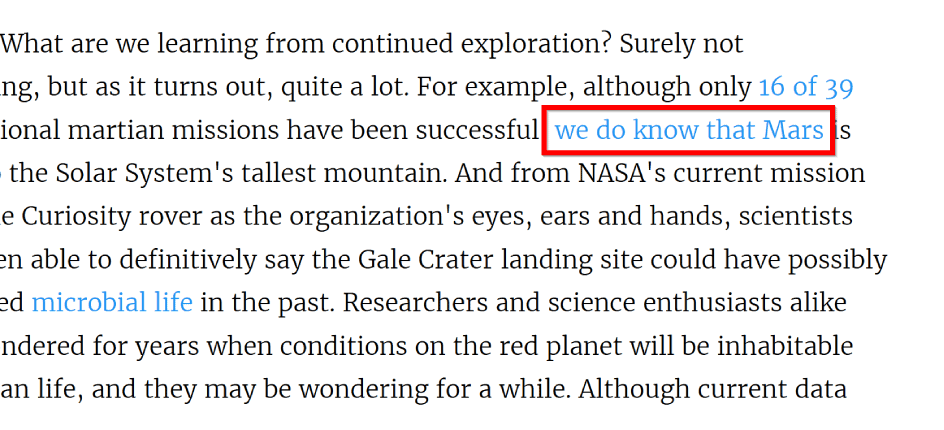
These white hat backlinks legitimately increased her natural traffic by 194.1%:
Why is skyscraper technology so effective?
According to Julie:
What makes this so successful is that it builds relationships and builds links with the same importance. People won't link to your content unless they know it exists, and they won't know your content exists unless you tell them.
Case Study 2
Broken chain building pays off
Last year I decided to run a broken link building campaign. So I followed the steps outlined in the previous chapter.
First, I used a search string to pull up pages with lots of outbound links. And I use "Check My Links" to find links that don't work.
I then emailed the person responsible for that content and told them about some broken links I had found:

(Notice how super personalized this email is)
When they replied, I sent them the URL of the broken link and a snippet of content I had posted that could be replaced 1:1, and because of the quality of the content, he was happy to add my content.
Case study 3
How Matt builds links to his e-commerce site
Let's face it: building links for e-commerce sites isn't easy.
But it's possible. Just look at Matt Lawry.
Like most e-commerce site owners, Matt had trouble building links for his e-commerce site, an Australian site focused on gifts.
After all, who wants to link to a 100% site that consists of product pages? It was then that Matt realized he could use content to generate links for his e-commerce site.
Specifically, Matt posted a great piece of skyscraper content on his site, "Australian Gin: The Ultimate Guide."
Of course, Matt didn't just sit back and wait for the links to roll in. He promoted his content via email:
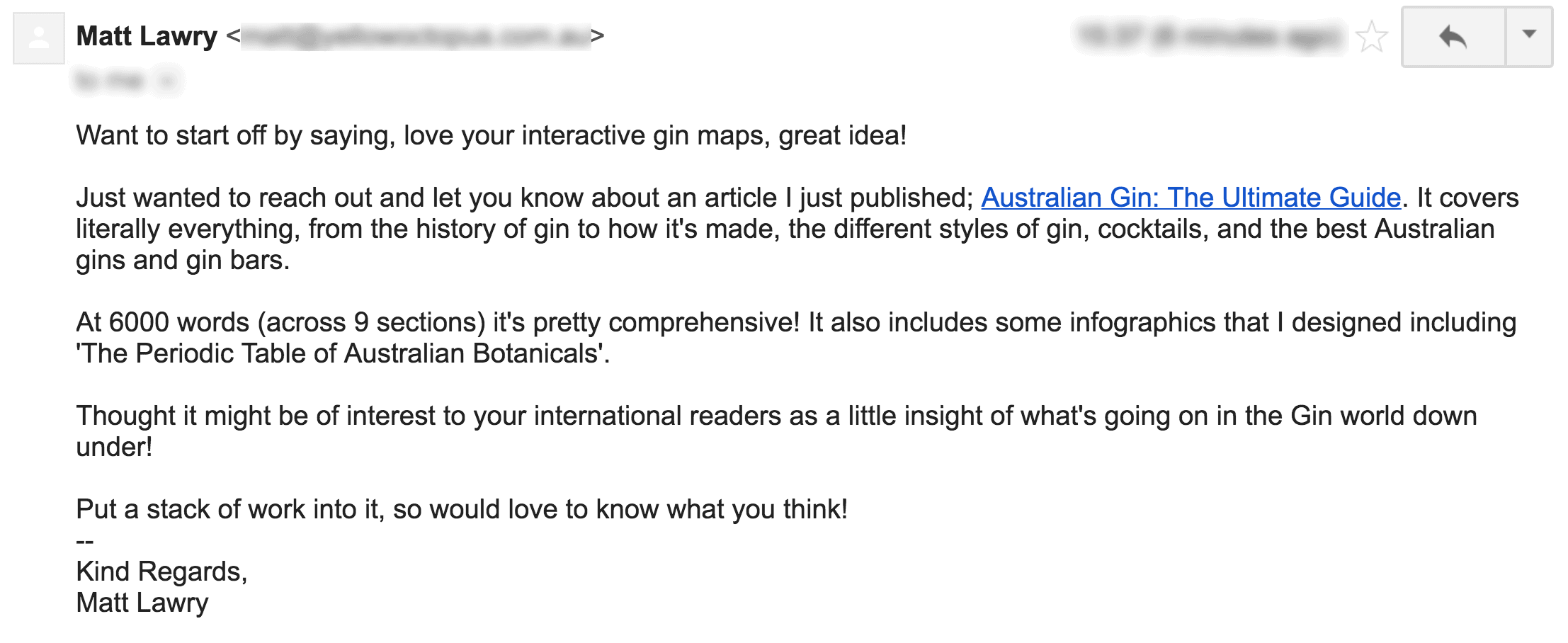
Because Matt reached out to the right people (and sent them personalized emails), a lot of people offered to link to his guide.

And all of these links improved Matt's rankings for a keyword that directly brings sales to his e-commerce site: Australian gin.
Chapter 8
High Quality External Link Building Tips
Here's a quick list of advanced link building tips I've accumulated over the years.
Getting Simple Links via Link Recycling
Whenever someone mentions your brand in a post, they link back to you ...... right?
Actually, no.
I mean, they should link to you, but odds are they won't.

But with a little push, most site owners are happy to convert your unlinked mentions.
How do you find these branded word mentions that aren't linked? Tools can be used:BuzzSumoThe results are great.

Using reverse image search to get "extra" links
Do you publish visual assets such as infographics? If so, then there may now be websites using your images without authorization.
That's a good thing in turn, just like link recycling, a friendly email can convert many of these opportunities into links.
You can use theGoogle ImagesReverse search to find peeps using your image without a link:

Send an email in the afternoon
One thing I've learned from sending thousands of outreach emails: send your outreach emails in the afternoon (the recipient's local time).
Why?
When you send a message in the morning, it gets mixed in with the other 93 e-mails that person has to deal with.
But when you send in the afternoon, there's much less competition in your inbox. I recommend using Gmail's built-in scheduled sending feature to help you schedule your promotional emails:
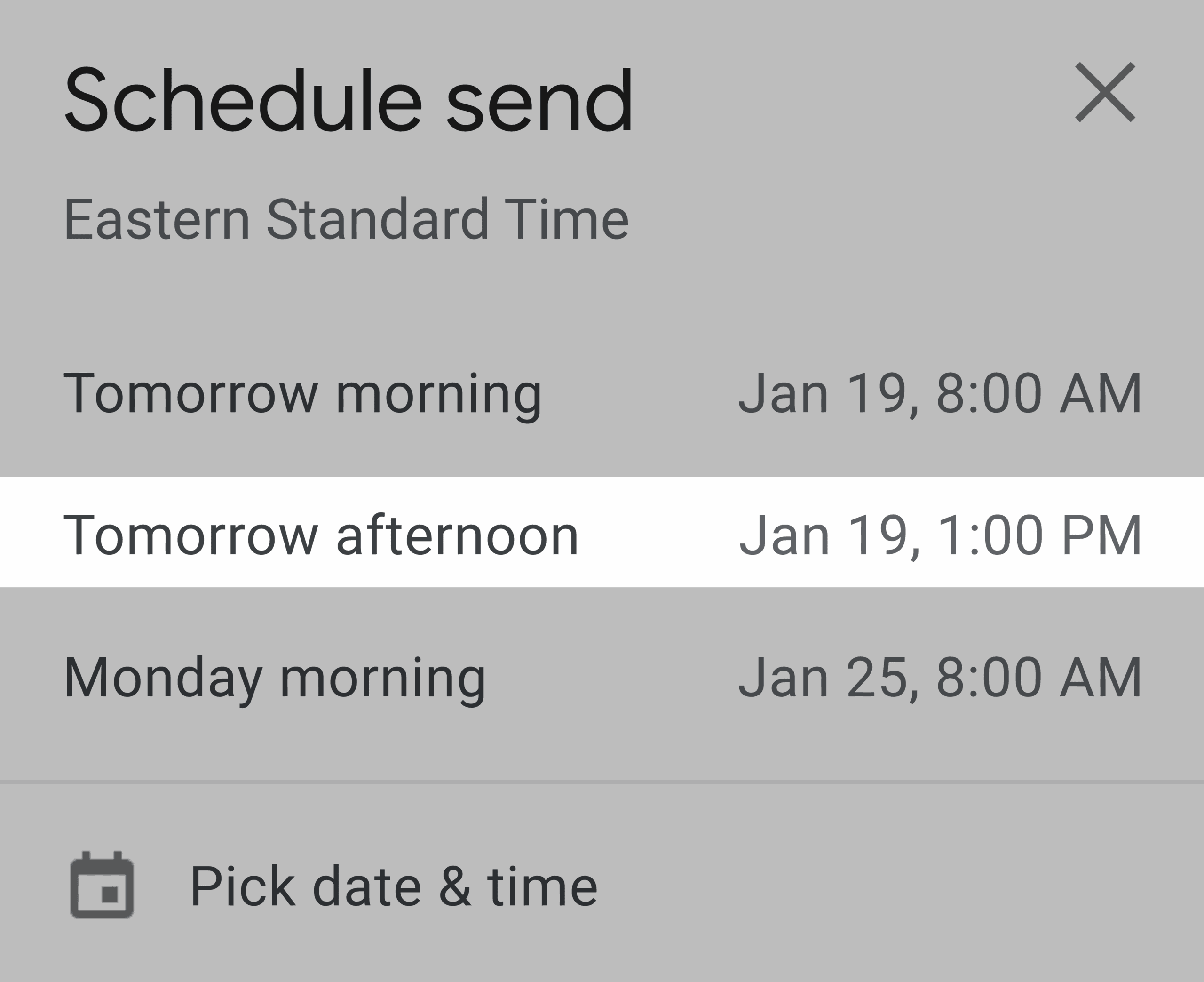
Create visualizations of concepts, ideas and strategies
Here's an example of a real-world application in Backlinko:

Believe it or not, a lot of people have linked to me due to this simple illustration:

Why does this work so well? One could simply describe the APP formula in words, but then my content wouldn't be as easy to share.
On the other hand, when you create a visualization, bloggers will be happy to use it in their content (and link to you when they do).
Send tentative emails before closing
Should you ask for a link in your first outreach email to someone?
In short: maybe.
You may get better results with a two-step process (reader Mike has found that tentative emails work far better than direct requests for links):
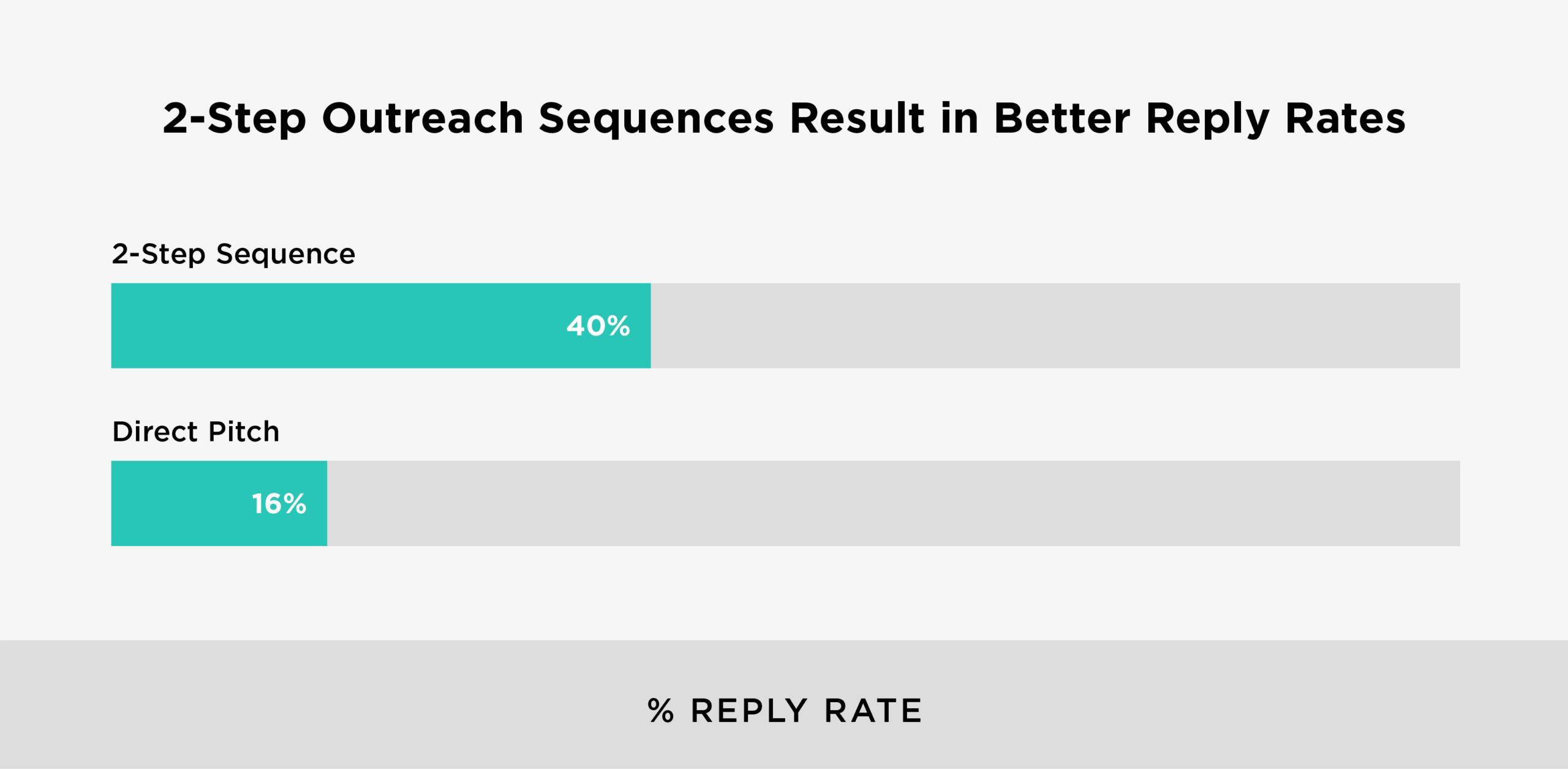
Another benefit of this approach is that it saves you time. Instead of personalizing outreach emails that no one will read, send short "test" emails.
Then personalize the next series of messages.
Interviewed on a podcast
Guest post links have their place, but they have one big problem: they take a lot of time to write!
And enter the realm of podcasting. Instead of outlining, drafting and editing guest posts, you just show up and talk about what you know. And - boom! -- you get a link.
The best part? There are podcasts on every topic. Here's an example of a link I created by appearing on the podcast: the
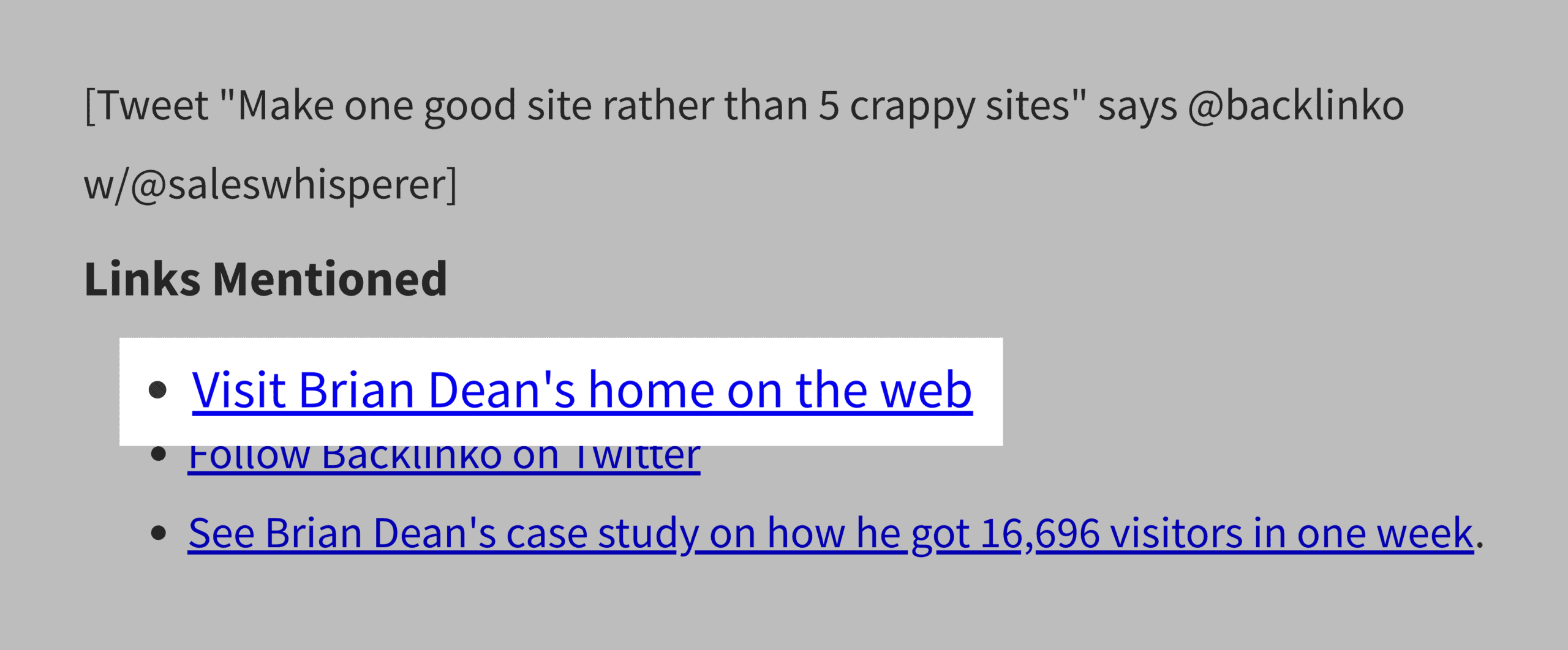
Use "link crossings" to discover possible linkers
If someone links to your competitor, they are likely to link to you as well. If someone links to two of your competitors, they are more likely to link to you.
How do I find sites that link to multiple competitors?
Semehr External Link Comparison and Analysis Tool
Only list your 2-3 biggest competitors and their websites and the tool will tell you who links to all those pages.

Use "pre-screening" to organize the list of targeted outbound links
There's no doubt about it: finding quality link targets is difficult, but these quality sites have been handpicked for you in the form of "best blogs" lists.
Here's an example:

If you run a baking blog, each of the sites listed here would be a great linking opportunity.
You can find such lists using search strings such as "best [topic] blogs" or "list of [topic] blogs".
reach a verdict
This is the latest outbound link building guide for 2024, hurry up and apply these effective optimization strategies to your website, recently releasedSEO Strategy: 10 practical steps for website SEO optimization in detailAlso find out.
 Gan Gongwang Anbei 36070002000003
Gan Gongwang Anbei 36070002000003